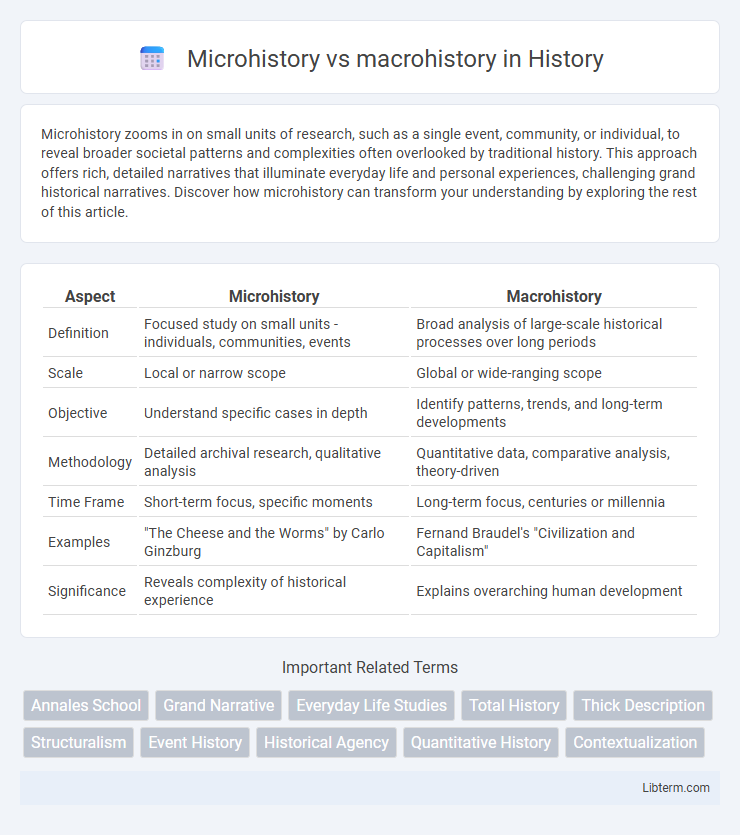Microhistory zooms in on small units of research, such as a single event, community, or individual, to reveal broader societal patterns and complexities often overlooked by traditional history. This approach offers rich, detailed narratives that illuminate everyday life and personal experiences, challenging grand historical narratives. Discover how microhistory can transform your understanding by exploring the rest of this article.
Table of Comparison
| Aspect | Microhistory | Macrohistory |
|---|---|---|
| Definition | Focused study on small units - individuals, communities, events | Broad analysis of large-scale historical processes over long periods |
| Scale | Local or narrow scope | Global or wide-ranging scope |
| Objective | Understand specific cases in depth | Identify patterns, trends, and long-term developments |
| Methodology | Detailed archival research, qualitative analysis | Quantitative data, comparative analysis, theory-driven |
| Time Frame | Short-term focus, specific moments | Long-term focus, centuries or millennia |
| Examples | "The Cheese and the Worms" by Carlo Ginzburg | Fernand Braudel's "Civilization and Capitalism" |
| Significance | Reveals complexity of historical experience | Explains overarching human development |
Introduction to Microhistory and Macrohistory
Microhistory examines detailed, small-scale events and individual experiences to uncover broader social, cultural, and historical patterns, emphasizing depth over breadth. Macrohistory analyzes large-scale historical processes, long-term trends, and structural changes across societies, focusing on broad patterns and generalizations. Both approaches offer complementary insights by balancing intensive analysis of specific cases with expansive views of historical developments.
Defining Microhistory: Scope and Approach
Microhistory focuses on detailed exploration of small units such as individuals, communities, or events to uncover broader social, cultural, and historical patterns. This approach emphasizes intensive analysis, often using primary sources like diaries, letters, and court records, to reveal complexities overlooked by broader narratives. By narrowing the scope, microhistory challenges grand generalizations, offering nuanced insights into everyday life and localized experiences.
Defining Macrohistory: Broad Perspectives
Macrohistory examines extensive periods and large-scale social, economic, and political structures to identify overarching patterns and long-term processes shaping civilizations. It emphasizes broad perspectives on historical change, integrating data across regions and eras to reveal general trends and systemic forces. This approach contrasts with microhistory's detailed focus on individual events or communities, aiming instead for holistic understanding of historical development.
Key Differences Between Microhistory and Macrohistory
Microhistory examines detailed, context-rich narratives of specific individuals, communities, or events, emphasizing qualitative analysis and localized perspectives. Macrohistory studies broad, large-scale historical patterns and trends across extensive periods or regions, relying on quantitative data and overarching frameworks. The key difference lies in microhistory's focus on depth and specificity versus macrohistory's emphasis on generalization and wide-ranging historical forces.
Methodologies in Microhistorical Research
Microhistorical research employs intensive, detailed analysis of a single event, individual, or community, utilizing primary sources such as diaries, court records, and letters to reconstruct nuanced historical narratives. This methodology emphasizes depth over breadth, focusing on the micro-level context to uncover broader social, cultural, or historical patterns. Contrasting with macrohistory's large-scale, quantitative approaches, microhistory relies heavily on interpretive techniques and qualitative data to reveal complexity within seemingly marginal or overlooked historical episodes.
Techniques Used in Macrohistorical Analysis
Macrohistorical analysis employs techniques such as quantitative data analysis and comparative historical methods to examine large-scale social, economic, and political patterns across extended time periods. It relies on extensive archival research, demographic statistics, and geospatial mapping to identify trends and structural changes influencing civilizations. Computational tools and big data analytics enhance the ability to synthesize vast amounts of historical information for comprehensive macro-level interpretations.
Case Studies: Microhistorical Examples
Microhistory focuses on detailed case studies such as Carlo Ginzburg's "The Cheese and the Worms," which examines the worldview of a 16th-century Italian miller to reveal broader cultural and social dynamics. This approach contrasts with macrohistory's sweeping narratives by emphasizing specific events, individuals, or communities to uncover the complexities of historical experiences. Case studies in microhistory provide granular insights that challenge generalized historical interpretations and highlight the diversity of human experiences across time.
Case Studies: Macrohistorical Examples
Macrohistorical examples in case studies emphasize broad patterns across large populations and extended timeframes, utilizing aggregated data to trace societal transformations such as industrialization or empire expansion. These studies rely on extensive archival sources, demographic statistics, and economic records to analyze trends like the rise of nation-states or global trade networks. By contrasting with microhistory, macrohistory provides insight into overarching historical forces shaping civilizations at a grand scale.
Strengths and Limitations of Each Approach
Microhistory excels in providing deep, detailed insights into specific events or individuals, uncovering nuanced social and cultural dynamics often overlooked by broader analyses. Its limitation lies in its narrow scope, which can make it difficult to generalize findings or understand large-scale historical trends. Macrohistory, by contrast, offers comprehensive perspectives on broad patterns and long-term processes, but it may oversimplify complex realities and neglect the richness found in localized, individual experiences.
Integrating Microhistory and Macrohistory in Historical Analysis
Integrating microhistory and macrohistory enriches historical analysis by combining detailed, localized case studies with broad societal and structural trends, offering a comprehensive understanding of past events. Microhistory's focus on individual experiences and specific contexts provides nuanced insights that challenge and refine the generalizations found in macrohistorical narratives. This synthesis enables historians to connect personal and community-level phenomena with larger political, economic, and cultural processes, enhancing the complexity and accuracy of historical interpretations.
Microhistory Infographic

 libterm.com
libterm.com